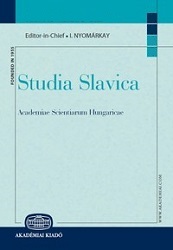Русско-венгерские паремиологические параллели (в поисках национальной специфики)
Russian–Hungarian Paremiological Parallels (in Search of National Specifics)
Author(s): Valery Mikhailovich Mokienko, Nikitina Tatiana GennadievnaSubject(s): Customs / Folklore, Semantics, Pragmatics, Comparative Linguistics, Finno-Ugrian studies, Eastern Slavic Languages
Published by: Akadémiai Kiadó
Keywords: comparative paremiology; paremiography; proverbs; sayings; variants of paremias; proverbial borrowings and calques; Russians and Hungarian paremiological parallels;
Summary/Abstract: Proverbs and sayings, which have always been considered the favourite genre of folklore and the representatives of the national mentality proper, have recently attracted particular attention of linguists. These are attempts to objectively establish the so-called “paremiological minimum” of different languages, the desire to measure the cognitive potential of the parеmias, and a broad comparative study of the proverbs and sayings of related and unrelated languages as well as a characteristic of the pragmatic capabilities of the latter. The present paper offers a comparative typological analysis of proverbs and sayings in the Russian and Hungarian languages. Despite their different genetic origins, it is in paremiology that there is a fairly large number of parallels of different types. The purpose of the paper is to identify such parallels and their classification by origin. The sources of such parallels are different: above all, longterm interaction with the paremiological systems of German and other European languages, including Slavic. Slavic paremiology, on the one hand, was a “donor” of borrowing in the form of tracing, on the other hand, it itself absorbed many Finno-Ugric paremias. That is why Hungarian paremiology and paremiography are of particular importance for comparative studies. And not only because the Hungarian language has historically absorbed a pan-European (including Slavic) paremiological heritage but also because Hungarian paremiography has long been one of the richest treasures of Hungarian and European small folklore. These collections of Hungarian proverbs and sayings against a broad interlanguage background are one of the most significant paremiological traditions. The rich paremiological collections accumulated by Hungarian researchers provide an opportunity for a detailed comparison of Slavic and Hungarian proverbs and sayings against a common European background and at the same time to trace the traces of direct Slavic–Hungarian contacts. Of particular importance in such a comparative study is the dialectal material, both in Hungarian and Slavic. When comparing the paremias of Russian and Hungarian languages, linguistic details are especially important, allowing to demonstrate the adaptation of the common European heritage to the Slavic and Finno-Ugric languages and to determine the proportion of similarities and differences between the respective paremias. It is not only genetic inertia but also the field of variation of borrowed proverbs and sayings that forms their national specificity. A comparative study shows that the Slavic variant proverb series look more compact and almost unchangeable. The variation of the Hungarian proverbs reveals a much wider amplitude, although it also retains the “classical” version as the main one. Some of them can be considered nationally specific despite the universality and globality of the range of some proverbs. The quota of national specificity for each of the options is different but it is the paremiological details that contain the national colour reflected in the language.
Journal: Studia Slavica Academiae Scientiarum Hungaricae
- Issue Year: 64/2019
- Issue No: 1
- Page Range: 85-102
- Page Count: 18
- Language: Russian
- Content File-PDF

